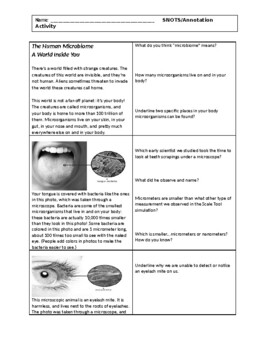Active Reading Strategies("SNOTS") for Amplify's "The Human Microbiome" Article
Michelle Holland
28 Followers
Grade Levels
5th - 8th
Subjects
Resource Type
Standards
CCSSCCRA.L.3
CCSSCCRA.L.4
CCSSCCRA.L.6
NGSSMS-LS1-7
NGSSMS-LS1-2
Formats Included
- Word Document File
Michelle Holland
28 Followers
Description
Are you looking for a way in which to constructively "break down" articles from Amplify into concise sections allowing for annotation skills ("SNOTS" -- "Small Notes on the Side") to be capitalized upon and active reading and writing skills to be embraced? Look no further than the way in which this article allows for students to make personal and meaningful connections to the text they are reading.
Total Pages
Answer Key
N/A
Teaching Duration
N/A
Report this resource to TPT
Reported resources will be reviewed by our team. Report this resource to let us know if this resource violates TPT’s content guidelines.
Standards
to see state-specific standards (only available in the US).
CCSSCCRA.L.3
Apply knowledge of language to understand how language functions in different contexts, to make effective choices for meaning or style, and to comprehend more fully when reading or listening.
CCSSCCRA.L.4
Determine or clarify the meaning of unknown and multiple-meaning words and phrases by using context clues, analyzing meaningful word parts, and consulting general and specialized reference materials, as appropriate.
CCSSCCRA.L.6
Acquire and use accurately a range of general academic and domain-specific words and phrases sufficient for reading, writing, speaking, and listening at the college and career readiness level; demonstrate independence in gathering vocabulary knowledge when encountering an unknown term important to comprehension or expression.
NGSSMS-LS1-7
Develop a model to describe how food is rearranged through chemical reactions forming new molecules that support growth and/or release energy as this matter moves through an organism. Emphasis is on describing that molecules are broken apart and put back together and that in this process, energy is released. Assessment does not include details of the chemical reactions for photosynthesis or respiration.
NGSSMS-LS1-2
Develop and use a model to describe the function of a cell as a whole and ways the parts of cells contribute to the function. Emphasis is on the cell functioning as a whole system and the primary role of identified parts of the cell, specifically the nucleus, chloroplasts, mitochondria, cell membrane, and cell wall. Assessment of organelle structure/function relationships is limited to the cell wall and cell membrane. Assessment of the function of the other organelles is limited to their relationship to the whole cell. Assessment does not include the biochemical function of cells or cell parts.





